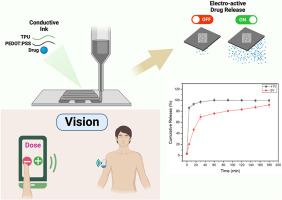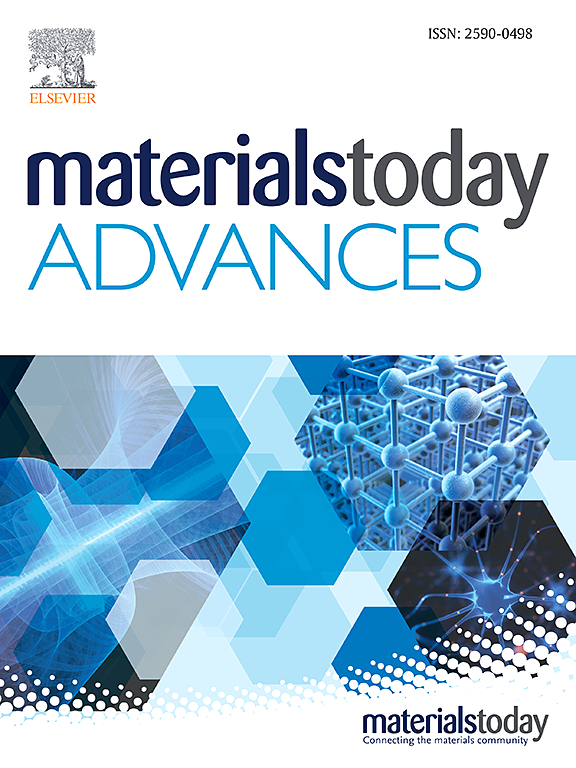可编程药物释放的 3D 打印电响应系统
IF 8
2区 材料科学
Q1 MATERIALS SCIENCE, MULTIDISCIPLINARY
引用次数: 0
摘要
精准医疗是制药研究的下一个前沿领域,旨在提高治疗药物对患者的安全性和有效性。理想的给药系统(DDS)应该是可编程的,能根据患者的需求提供实时可控的个性化给药。然而,在这一领域取得的进展甚微。在这里,我们将导电聚合物(CPs)和三维打印这两项尖端技术结合起来,展示它们在实现可编程控制释放方面的潜力。我们配制了一种 DDS,其中的导电聚合物可对药物释放进行时间控制。三维打印用于确保对 DDS 设计的尺寸控制。众所周知,本研究中使用的氯化石蜡易碎,因此将其与热塑性聚氨酯(TPU)混合,以获得具有良好机械性能的导电弹性体。流变学和机械分析表明,存储模量在 10-10 Pa 左右的配方油墨既可挤出,又能保持结构的完整性。物理化学分析证实了三维打印 DDS 中存在 CP 官能团。循环伏安法表明,DDS 在 100 次刺激后仍能保持导电性。在不同电压下进行了 180 分钟的药物释放试验,观察到在±1.0 V 和被动释放之间的累积释放量存在显著差异(< 0.05)。此外,还测试了 DDS 对脉冲刺激的反应能力,发现它能对电压刺激做出快速反应,从而改变释放机制。这项研究是首次使用氯化石蜡三维打印电活性药物,为可集成到物联网(IoT)框架中的 DDS 数字化铺平了道路。本文章由计算机程序翻译,如有差异,请以英文原文为准。

3D printed electro-responsive system with programmable drug release
Precision medicine is the next frontier in pharmaceutical research, aiming to improve the safety and efficacy of therapeutics for patients. The ideal drug delivery system (DDS) should be programmable to provide real-time controlled delivery that is personalised to the patient's needs. However, little progress has been made in this domain. Herein, we combined two cutting-edge technologies, conductive polymers (CPs) and three-dimensional (3D) printing, to demonstrate their potential for achieving programmable controlled release. A DDS was formulated where the CP provided temporal control over drug release. 3D printing was used to ensure dimensional control over the design of the DDS. The CP used in this study is known to be fragile, and thus was blended with thermoplastic polyurethane (TPU) to achieve a conductive elastomer with sound mechanical properties. Rheological and mechanical analyses were performed, where it was revealed that formulation inks with a storage modulus in the order of 10–10 Pa were both extrudable and maintained their structural integrity. Physico-chemical analysis confirmed the presence of the CP functional groups in the 3D printed DDS. Cyclic voltammetry demonstrated that the DDS remained conductive for 100 stimulations. drug release was performed for 180 min at varying voltages, where a significant difference ( < 0.05) in cumulative release was observed between either ±1.0 V and passive release. Furthermore, the responsiveness of the DDS to pulsatile stimuli was tested, where it was found to rapidly respond to the voltage stimuli, consequently altering the release mechanism. The study is the first to 3D print electroactive medicines using CPs and paves the way for digitalising DDS that can be integrated into the Internet of Things (IoT) framework.
求助全文
通过发布文献求助,成功后即可免费获取论文全文。
去求助
来源期刊

Materials Today Advances
MATERIALS SCIENCE, MULTIDISCIPLINARY-
CiteScore
14.30
自引率
2.00%
发文量
116
审稿时长
32 days
期刊介绍:
Materials Today Advances is a multi-disciplinary, open access journal that aims to connect different communities within materials science. It covers all aspects of materials science and related disciplines, including fundamental and applied research. The focus is on studies with broad impact that can cross traditional subject boundaries. The journal welcomes the submissions of articles at the forefront of materials science, advancing the field. It is part of the Materials Today family and offers authors rigorous peer review, rapid decisions, and high visibility.
 求助内容:
求助内容: 应助结果提醒方式:
应助结果提醒方式:


